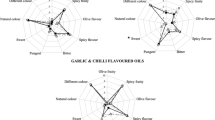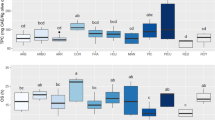Abstract
In order to analyze possible sensory variations in extra virgin olive oils (EVOOs) by a trained sensory panel, three degree of maturity (DM) of Arbequina olives (green, verdant, and ripe) and four beat times (BT) of 30, 40, 50, and 60 min were studied during the production process. In this sense, twelve different elaboration forms of EVOO, monovarietal from Serra da Mantiqueira, were analyzed. Analyses of acidity, peroxide index, specific extinction, and descriptive sensory were performed on olive oils. The results were analyzed by parametric and nonparametric statistics according to the assumptions of ANOVA. The sensory profiles of the elaborated EVOOs showed different characteristics; the EVOOs of the DM green and verdant with BT 50 highlighted for “pungency” and sensory evolution harmonious and balanced; the BT 60 obtained the highest values for “green fruity,” and the DM ripe with BT 40 showed balance to the sensory attributes. From these results, it is possible to structure protocols for the preparation of olive oil in order to achieve an oil with desirable sensory characteristics.



Similar content being viewed by others
References
Amanpour A, Kelebek H, Selli S (2019) Characterization of aroma, aroma-active compounds and fatty acids profiles of cv. Nizip Yaglik oils as affected by three maturity periods of olives. Eur Food Res Technol 99(2):726–740
Aued-pimentel S, Separovic L (2017) Fraude em azeites de oliva do comércio brasileiro : avaliação pelo perfil de ácidos graxos , diferença do ECN 42 e parâmetros de qualidade Fraud in olive oils of Brazilian market: evaluation by fatty acid profile, difference of ECN 42 and quality parameters. REvista Visa Em Debate 5(3):84–91
Aykan S, Vatansever G, Doğanay-Erdoğan B, Kalaycıoğlu C (2020) Development of Sensory Sensitivity Scales (SeSS): reliability and validity analyses. Res Dev Disabil 100(February):103612. https://doi.org/10.1016/j.ridd.2020.103612
Borges TH, Pereira JA, Cabrera-Vique C, Lara L, Oliveira AF, Seiquer I (2017) Characterization of Arbequina virgin olive oils produced in different regions of Brazil and Spain: physicochemical properties, oxidative stability and fatty acid profile. Food Chem 215:454–462. https://doi.org/10.1016/j.foodchem.2016.07.162
Cano-Lamadrid M, Hernández F, Corell M, Burló F, Legua P, Moriana A, Carbonell-Barrachina ÁA (2017) Antioxidant capacity, fatty acids profile, and descriptive sensory analysis of table olives as affected by deficit irrigation. J Sci Food Agric 97(2):444–451. https://doi.org/10.1002/jsfa.7744
Caponio F, Gomes T, Pasqualone A (2001) Phenolic compounds in virgin olive oils: influence of the degree of olive ripeness on organoleptic characteristics and shelf-life. Eur Food Res Technol 212(3):329–333. https://doi.org/10.1007/s002170000268
CEE (2005) Regulamento (CEE) n. 2568/91 da Comissão das Comunidades Europeias. J Oficial 50:1–54
Contreras M del M, Arroyo-Manzanares N, Arce C, Arce L (2019) HS-GC-IMS and chemometric data treatment for food authenticity assessment: Olive oil mapping and classification through two different devices as an example. Food Control 98:82–93. https://doi.org/10.1016/j.foodcont.2018.11.001
Crizel RL, Hoffmann J, Zandoná F, Lobo GP, Shild PM, Jorge, Rogerio Oliveira Chaves, F. C. (2020) Characterization of extra virgin olive oil from Southern Brazil. Eur J Lipid Sci Technol 122(4):1900347
Dourou AM, Brizzolara S, Meoni G, Tenori L, Famiani F, Luchinat C, Tonutti P (2020) The inner temperature of the olives (cv. Leccino) before processing affects the volatile profile and the composition of the oil. Food Res Int 129(November 2019). https://doi.org/10.1016/j.foodres.2019.108861
Esposto S, Veneziani G, Taticchi A, Selvaggini R, Urbani S, Di Maio I, Sordini B, Minnocci A, Sebastiani L, Servili M (2013) Flash thermal conditioning of olive pastes during the olive oil mechanical extraction process: impact on the structural modifications of pastes and oil quality. J Agric Food Chem 61(20):4953–4960. https://doi.org/10.1021/jf400037v
Fernandes-Silva AA, Falco V, Correia CM, Villalobos FJ (2013) Sensory analysis and volatile compounds of olive oil (cv. Cobrançosa) from different irrigation regimes. Grasas y Aceites 64(1):59–67. https://doi.org/10.3989/gya.069712
Fortini M, Migliorini M, Cherubini C, Cecchi L, Guerrini L, Masella P, Parenti A (2016) Shelf life and quality of olive oil filtered without vertical centrifugation. Eur J Lipid Sci Technol 118(8):1213–1222. https://doi.org/10.1002/ejlt.201500229
Freire LTV, Cabrita MJ, Da Silva MDRG, Freitas AMC (2011) Sensorial analysis and electronic aroma detection to compare olive oils produced by different extraction methods. Grasas y Aceites 62(4):428–435. https://doi.org/10.3989/gya.010411
Hachicha Hbaieb R, Kotti F, Gargouri M, Msallem M, Vichi S (2016) Ripening and storage conditions of Chétoui and Arbequina olives: Part I. Effect on olive oils volatiles profile. Food Chem 203:548–558. https://doi.org/10.1016/j.foodchem.2016.01.089
IOC. (2018). Sensory analysis of olive oil - method for the organoleptic assessment of virgin olive oil. International Olive Council, 10(15), Madrid. http://www.internationaloliveoil.org/estaticos/view/224-testing-methods
de Jesus Silva G, Gonçalves B-HRF, Conceição DG, Fontan GCR, Santos LS, Ferrão SPB (2020) Multivariate analysis applied for correlations between analytical measures and sensory profile of goat milk chocolate. Journal of Food Science and Technology 57:444–453
Latimer GWJ (2012) Official methods of analysis of AOAC International, 19th edn
Lukić I, Carlin S, Horvat I, Vrhovsek U (2019) Combined targeted and untargeted profiling of volatile aroma compounds with comprehensive two-dimensional gas chromatography for differentiation of virgin olive oils according to variety and geographical origin. Food Chem 270(March 2018):403–414. https://doi.org/10.1016/j.foodchem.2018.07.133
Miho H, Moral J, López-gonzález MA, Díez CM, Priego-Capote F (2020) The phenolic profile of virgin olive oil is influenced by malaxation conditions and determines the oxidative stability. Food Chem 314(August 2019):126183. https://doi.org/10.1016/j.foodchem.2020.126183
Modolo, J. S. (2007). Quantificação de estigmastadienos em azeite de oliva (olea europaea l .) por cromatografia em fase gasosa. Universidade Estadual de Campinas.
Monasterio RP (2013) Olive oil by capillary electrophoresis: characterization and genuineness. https://doi.org/10.1021/jf400864q
Önal-Hartmann C, Fiorio M, Gentner R, Zeller D, Pauli P, Classen J (2012) After-training emotional interference may modulate sequence awareness in a serial reaction time task. Exp Brain Res 219:75–84. https://doi.org/10.1007/s00221-012-3068-x
Puértolas E, Martínez De Marañón I (2015) Olive oil pilot-production assisted by pulsed electric field: impact on extraction yield, chemical parameters and sensory properties. Food Chem 167:497–502. https://doi.org/10.1016/j.foodchem.2014.07.029
Restuccia D, Clodoveo ML, Corbo F, Loizzo MR (2018) De-stoning technology for improving olive oil nutritional and sensory features: the right idea at the wrong time. Food Res Int 106(February):636–646. https://doi.org/10.1016/j.foodres.2018.01.043
Rodrigues N, Casal S, Peres AM, Baptista P, Bento A, Martín H, Asensio-S.-Manzanera, M. C., & Pereira, J. A. (2018) Effect of olive trees density on the quality and composition of olive oil from cv. Arbequina. Scientia Horticulturae 238(May):222–233. https://doi.org/10.1016/j.scienta.2018.04.059
Rodrigues N, Casal S, Peres AM, Baptista P, Pereira JA (2020) Seeking for sensory differentiated olive oils? The urge to preserve old autochthonous olive cultivars. Food Res Int 128(January 2019):108759. https://doi.org/10.1016/j.foodres.2019.108759
Sánchez-ortiz A, Bejaoui MA, Quintero-flores A, Jiménez A, Beltrán G (2018) Biosynthesis of volatile compounds by hydroperoxide lyase enzymatic activity during virgin olive oil extraction process. Food Res Int 111(May):220–228. https://doi.org/10.1016/j.foodres.2018.05.024
Taticchi A, Selvaggini R, Esposto S, Sordini B, Veneziani G, Servili M (2019) Physicochemical characterization of virgin olive oil obtained using an ultrasound-assisted extraction at an industrial scale: influence of olive maturity index and malaxation time. Food Chem 289(November 2018):7–15. https://doi.org/10.1016/j.foodchem.2019.03.041
Yuan H, Chen X, Shao Y, Cheng Y, Yang Y, Zhang M, Hua J, Li J, Deng Y, Wang J, Dong C, Jiang Y, Xie Z, Wu Z (2019) Quality Evaluation of Green and Dark Tea Grade Using Electronic Nose and Multivariate Statistical Analysis. Journal of Food Science 84:3411–3417
Acknowledgements
The authors gratefully acknowledge the Coordination for the Improvement of Higher Level Personnel–CAPES for their financial assistance, Serra que Chora Farm, and Agriculture Research Company of Minas Gerais (EPAMIG) for their support.
Availability of Data and Materials
Not applicable
Code Availability
Not applicable
Funding
This work was funded by of the Coordination for the Improvement of Higher Level Personnel–CAPES.
Author information
Authors and Affiliations
Contributions
Amanda Neris dos Santos: methodology, data curation, writing—original draft. Luiz Fernando de Oliveira da Silva: methodology—review. Camila Argenta Fante: supervision, writing—review. The author(s) read and approved the final manuscript.
Corresponding author
Ethics declarations
Ethics Approval
Sensory analysis was performed according to the release registered with CAAE number 80263617.3.0000.5149.
Consent to Participate
As required by the COEP/UFMG Ethics Committee, all participants signed the Informed Consent Form-TCLE, and such documents were signed in two copies, the researcher’s copy remaining on file, under confidentiality, as recommended by resolution CNS 466/12.
Consent for Publication
Not applicable.
Conflicts of Interest
Amanda Neris dos Santos declares that she has no conflict of interest. Luiz Fernando de Oliveira da Silva declares that he has no conflict of interest. Camila Argenta Fante declares that she has no conflict of interest.
Additional information
Publisher’s Note
Springer Nature remains neutral with regard to jurisdictional claims in published maps and institutional affiliations.
Rights and permissions
About this article
Cite this article
dos Santos, A.N., de Oliveira da Silva, L.F. & Fante, C.A. Sensory Variations in Olive Oils from the Arbequina Variety Elaborated with Changes in Fruit Selection and Process. Food Anal. Methods 14, 1645–1653 (2021). https://doi.org/10.1007/s12161-021-01997-3
Received:
Accepted:
Published:
Issue Date:
DOI: https://doi.org/10.1007/s12161-021-01997-3




